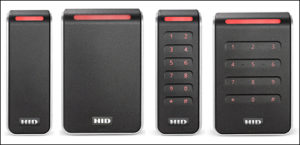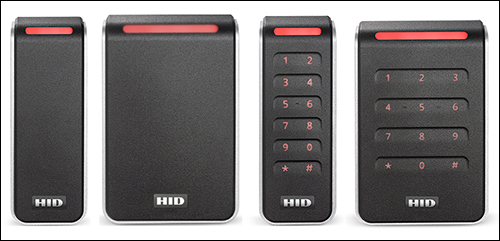As more access-control technologies and related software platforms are being deployed at businesses, schools and other facilities, the need for a universal access-control gate led HID Global to develop a new family of products. The company’s HID Signo reader units are aimed at those requiring greater security and flexibility in digital access control.
The Signo readers are interoperable with more than a dozen physical and mobile credential technologies, the company reports. Each device offers passive 125 kHz low-frequency (LF) and 13.56 MHz high-frequency (HF) RFID, as well as Bluetooth Low Energy (BLE) functionality and compatibility with a controller using the Open Supervised Device Protocol (OSDP) for connectivity. The readers also come with Secure Element (SE) hardware to protect authentication keys for security, says Brandon Arcement, HID Global’s senior director of product marketing.

The product line is the latest generation of HID’s access-control products since the Texas technology company released its iCLASS access-control readers in 2002 and iCLASS SE reader platform in 2013. The Signo readers are designed to operate with legacy technology, the firm reports, and to offer forward compatibility for future technologies that could be used to access doors and gates.
At present, companies and organizations are using a variety of technologies to allow individuals to enter a secure space. “The breadth of credentials now being carried and the options available to read those credentials [have grown],” Arcement says. To meet the needs of these facilities, he adds, “It’s necessary to have something that functions as a Swiss Army knife.”
Traditionally, HID Global has served enterprise customers and schools, and has worked with partners such as installers, distributors and service providers. Throughout the past decade, users have been leveraging an increasingly diverse set of technologies, including RFID, Bluetooth and other contactless solutions, employing badges and access-control cards as well as mobile phones, using Android and iOS, including programs such as student IDs in Apple Wallet. The HID Signo reader line is intended to address that growth and diversification, Arcement explains.
There are four versions of the Signo readers. Two are designed for wall switch mounts, one with a keypad and one without, while the other two are intended for door mullion mounting, either with or without a keypad. Each comes with front-end technology for users to access doors and gates, Secure Elements inside to protect the security of interactions, and a communication feature that works with both the more traditional Weigand and recently released OSDP.
On the front end, each unit has three antennas built in: LF for 125 kHz proximity cards, as well as HF for 13.56 MHz, compliant with both the ISO 14443 and 15693 standards for contactless smartcards and Near Field Communication (NFC)-based access (either with a badge or a smartphone.) The third antenna is dedicated to Bluetooth 2.4 GHz so users can be authorized to access a building or gate via their phone or BLE device from a greater distance than contactless smart-card or NFC specifications allow. With the variety of communication options, Arcement says, “We could get really innovative with our offerings.” For instance, a device could provide contactless access for employees, and could also include NFC and BLE access for other specific use cases.
At the center of the Signo readers are two other pieces of hardware, the company reports. One is the embedded Secure Element with cryptographic operations. This SE has been a feature HID Global has offered to customers since 2011. However, the most recent version of the SE used in the Signo reader line is larger and offers better performance, Arcement says, with greater capacity and higher security certification, along with more expandability and agility in case new technologies are added in the future.
When it comes to security, Arcement says, “We’re known for credential support, and this takes us to the next level.” The new product can cryptographically authenticate their unique ID number from a user’s badge or phone, then communicate that data to a panel connected to the access system.
For connecting the device to access controls and a server, there are two options. According to Arcement, more than 90 percent of access-control systems still use a Wiegand interface between the reader and the access control platform, which only allows for one-way communication and is unencrypted; therefore, it has significant vulnerabilities. “Signo includes OSDP as a configuration option in every reader,” he states, so those who upgrade to OSDP can take advantage of communications system that are less vulnerable. OSDP, an open standard developed by Mercury Security and HID Global in 2008, provides encryption and enables bidirectional communications.
A customer can install the system with the existing Weigand protocol, but with OSDP, it can address vulnerabilities in the legacy technology. “If our market was all greenfield,” Arcement says, “we wouldn’t need support for the [Weigand] legacy, but it’s necessary to support existing technology while allowing for transition as budgets allow.”
The reader’s redesign was driven by two factors, Arcement says: explicit customer requests and implied requests based on support issues. For instance, the company observed that there were many technical support calls about ensuring the system operated when the device was mounted on metal. Thus, the firm also built in what it calls the “automatic surface detection” to identify if there is metal in the environment, and to automatically recalibrate its own RF settings accordingly.
The unit is designed with an IP-65 rating for use in outdoor environments. “Our readers are often installed in harsh conditions outdoors,” Arcement says. The company, he notes, has devices installed in areas ranging from parking lots in Scandinavia to outdoor facilities in Saudi Arabia. In addition, HID has built what it calls “agility”—being able to respond to the unexpected—into the system. “Today, one of the drawbacks of existing readers is that they are disconnected,” he explains. By connecting the device to a server, he says, “We have designed for a connected environment,” which enables health and status monitoring, as well as firmware updates that systems integrators could provide to end users.
HID Global provides tools that allow partners to configure the device according to a user’s specific needs. The company offers its HID Reader Manager App to configure the settings available for iOS- and Android-based devices. HID is making the Signo readers available through its partners, and has worked with architects, designers, installers and potential end users to create the design throughout the past several years.
The device was announced in early March 2020 and is now in full production. Several dozen customers have been beta-testing the units. “This is a new beginning,” Arcement states. “It’s our expectation that we will continue to build off of this. There will be new models and new capabilities. The common theme is that we want to enable the market and push the market toward a more secure and seamless, more digital, access experience.”


